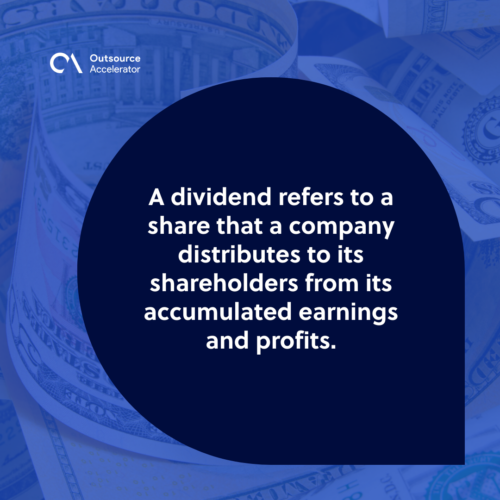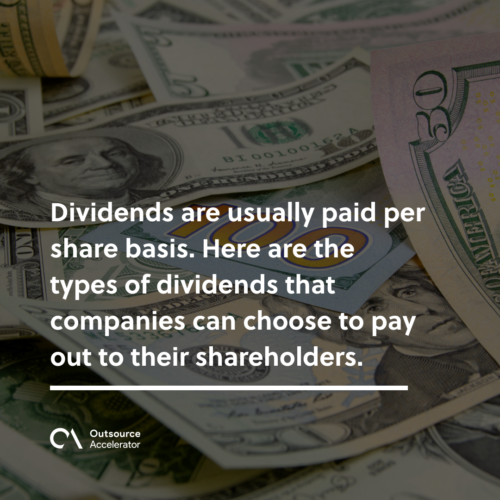Dividend
Definition
What is a dividend?
A dividend refers to a share that a company distributes to its shareholders from its accumulated earnings and profits. It can be in the form of cash payments, assets, and additional stocks.
Declaration of dividends reflects a company’s earning capabilities. Some companies disburse lump-sum payments to reward their shareholders. Although not all businesses can pay out dividends, there isn’t a law obliging companies to do so.
A board meeting is done to check if there is available profit before declaring dividends. The total dividend to be given to shareholders will then be decided by the board of directors. As for its release, it needs the shareholder’s approval before it is issued.
Examples of well-established companies that can disburse dividends are Apple, Microsoft, Wells Fargo, and Verizon.

Two classifications of dividend
There are two classifications of dividend – preferred dividend and common dividend:
- Preferred dividend – given to shareholders with preferred shares. Preferred dividends are prioritized over common dividends.
- Common dividend – given to shareholders with common shares. Common shareholders are always the last in line in terms of dividend payments.
Types of dividends
Dividends are usually paid per share basis. Here are the types of dividends that companies can choose to pay out to their shareholders.
Cash dividends
This is the most common type of dividend. It is a payment in cash form directly to investors’ brokerage accounts.
Stock dividends
Stock dividends are given through additional shares. It is paid out for a specific period and is usually tax-exempt.
Property dividends
Property dividends refer to the company’s assets such as real estate, stocks, investment securities, and other properties.
Liquidating dividends
Liquidating dividend is a type of dividend that is disbursed to shareholders as a part of a company’s liquidation process. Moreover, the liquidation process is done when a company decides to stop running as it can no longer sustain its daily operations.
Liquidating dividend is paid to shareholders as a return of capital and is usually non-taxable.

When are dividends paid?
Below are three essential dates for allocating dividend payments:
Declaration date
This is when a company’s management declares there is a dividend to be paid. The board of directors will then vote on whether to pay it, including the date on which the dividend will be issued.
Ex-dividend date
This is the date when a company determines which shareholders will receive dividends. It is an important date for investors as they need to own a stock before the ex-dividend date to receive a dividend.
Payment date
This is when the dividend is credited to shareholders.
Some companies choose not to pay dividends. Instead, they reinvest the profits in the business itself to sustain its growth and expansion. This also means more capital gains for shareholders.
Generally, companies issuing dividends aim to attract more investors. The issuance of dividends keeps major investors consistently buying a company’s stocks. If investors continuously reinvest in a business, it will lead to huge earnings and a much higher stock price.







 Independent
Independent




